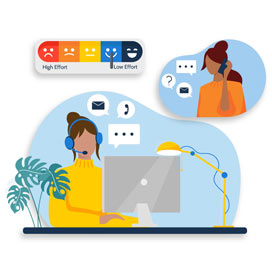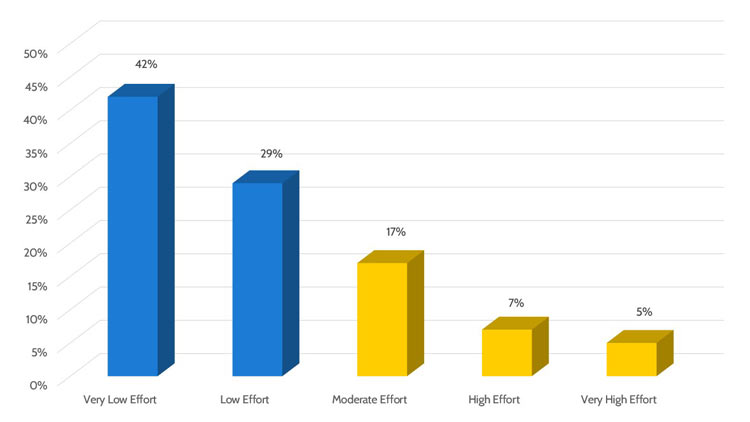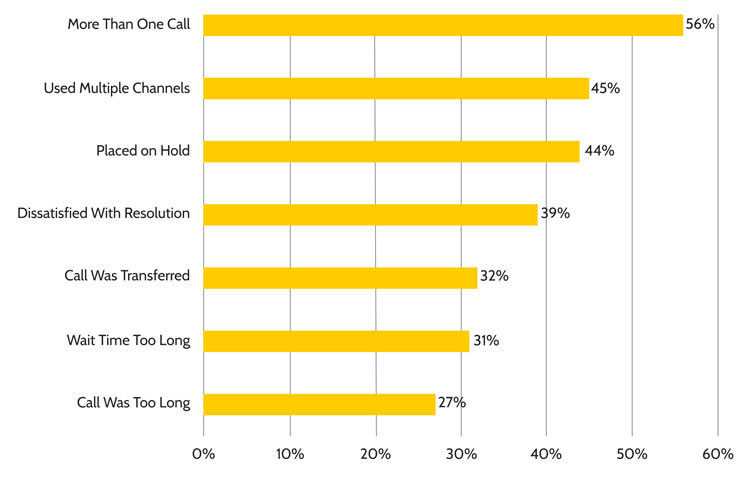Customer Effort Required To Resolve A Call
SQM's Voice of the Customer (VoC) research shows that 71% of calls are resolved on the first call for the average call center, which means 29% of customers have to call back because their issue was not resolved on the first call. Additionally, of the 500 leading North American call centers SQM benchmarks annually, only 5% of them are at the world-class VoC First Call Resolution (FCR) performance level of 80% or higher.

The customer effort metric is an excellent question to ask customers how much effort was needed to resolve their call. Figure 1 shows the breakdown of customer effort required to resolve a call. 71% of customers felt they made a low to very low effort to resolve their call. Conversely, 29% of customers felt they had to make a moderate to very high effort to resolve their call.
SQM research reveals that when calls are resolved on their first call, the customer effort is low or very low. Conversely, when the call is unresolved, customer effort is moderate to very high effort. Obviously, the more calls needed to resolve the call, the higher the customer effort is required to resolve their call.
Figure 1: Customer Effort Required to Resolve a Call

Figure 2 shows a ranking of the reasons when high or very high customer effort is required to resolve their call. 'Making more than one call or using multiple contact channels to resolve their inquiry or problem are the biggest drivers of high customer effort.' 'Placed on hold,' 'dissatisfaction with the resolution,' and 'call was transferred' are also significant drivers of the high customer effort required to resolve their calls.
Figure 2: Reasons Why High Customer Effort is Required

FCR and Call Resolution Impact on Customer Defections
Figure 3 shows when the call is resolved on the first call, only 5% of those customers expressed their intent to defect. Put differently, 95% of customers expressed intent to continue doing business with an organization when FCR is achieved.
When it took repeated calls to resolve their call, 9% of those customers expressed their intent to defect. However, it is worth mentioning that 12% of calls go unresolved for the call center industry average. Therefore, an alarming 25% of those customers expressed their intent to defect when the calls were unresolved.
Clearly, for call centers to retain customers, they must resolve the customer's call, and preferably on the first call. Yet, astonishingly, the vast majority of call centers do not measure whether they have retained customers or whether their customers will defect due to their call center experience for resolving their call.
Without knowing whether or not they have retained customers, call center leaders have no idea how much of the company's revenue loss is due to customers defecting due to their call center experience for resolving their call. For example, a critical finding in Figure 3 is that when a customer's call is unresolved, they are five times more likely to defect than a customer whose call is resolved on the first call.
Figure 3: Call Resolution Metrics Impact on Customer Defections

Quick Related Links
First Call Resolution Definition First Call Resolution PPT First Call Resolution Benefits
First Call Resolution Strategies First Call Resolution Operating Philosophy Outside-In of Inside-Out First Call Resolution Formula Calculate First Call Resolution Rate What is a Good FCR Rate? One Call Resolution Channel Hopping
